
Fornax is a constellation in the southern celestial hemisphere, partly ringed by the celestial river Eridanus. Its name is Latin for furnace. It was named by French astronomer Nicolas Louis de Lacaille in 1756. Fornax is one of the 88 modern constellations.

An elliptical galaxy is a type of galaxy with an approximately ellipsoidal shape and a smooth, nearly featureless image. They are one of the three main classes of galaxy described by Edwin Hubble in his Hubble sequence and 1936 work The Realm of the Nebulae, along with spiral and lenticular galaxies. Elliptical (E) galaxies are, together with lenticular galaxies (S0) with their large-scale disks, and ES galaxies with their intermediate scale disks, a subset of the "early-type" galaxy population.

NGC 1316 is a lenticular galaxy about 60 million light-years away in the constellation Fornax. It is a radio galaxy and at 1400 MHz is the fourth-brightest radio source in the sky.

NGC 1427 is a low-luminosity elliptical galaxy located approximately 71 million light-years away from Earth. It was discovered by John Frederick William Herschel on November 28, 1837. It is a member of the Fornax Cluster. The galaxy has a stellar mass of 7.9 × 1010M☉, and a total mass of 9.4 × 1010M☉. However, the mass of the dark matter halo surrounding the galaxy is around 4.3 × 1012M☉.
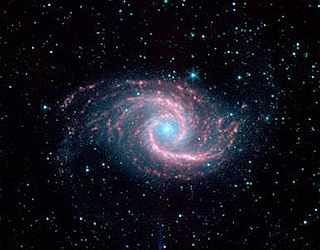
The Dorado Group is a loose concentration of galaxies containing both spirals and ellipticals. It is generally considered a 'galaxy group' but may approach the size of a 'galaxy cluster'. It lies primarily in the southern constellation Dorado and is one of the richest galaxy groups of the Southern Hemisphere. Gérard de Vaucouleurs was the first to identify it in 1975 as a large complex nebulae II in the Dorado region, designating it as G16.
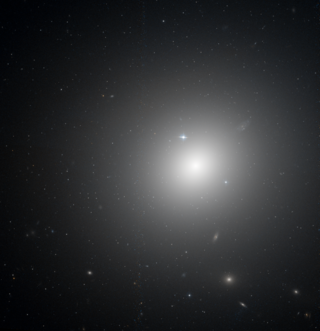
NGC 1399 is a large elliptical galaxy in the Southern constellation Fornax, the central galaxy in the Fornax Cluster. The galaxy is 66 million light-years away from Earth. With a diameter of 130 000 light-years, it is one of the largest galaxies in the Fornax Cluster and slightly larger than the Milky Way. William Herschel discovered this galaxy on October 22, 1835.
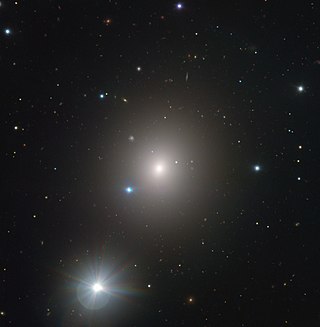
NGC 1404 is an elliptical galaxy in the Southern constellation Eridanus. It was discovered on November 28, 1837, by the astronomer John Herschel. Based on the tip of the red-giant branch distance indicator, it lies at a distance of approximately 60 million light-years from the Milky Way. It is one of the brightest members of the Fornax Cluster.
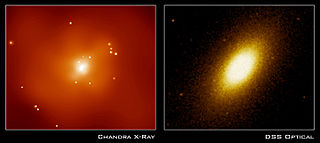
NGC 720 is an elliptical galaxy located in the constellation Cetus. It is located at a distance of circa 80 million light years from Earth, which, given its apparent dimensions, means that NGC 720 is about 110,000 light years across. It was discovered by William Herschel on October 3, 1785. The galaxy is included in the Herschel 400 Catalogue. It lies about three and a half degrees south and slightly east from zeta Ceti.
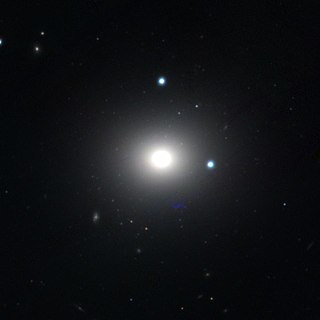
NGC 1395 is an elliptical galaxy located in the constellation Eridanus. It is located at a distance of circa 75 million light years from Earth, which, given its apparent dimensions, means that NGC 1395 is about 130,000 light years across. It was discovered by William Herschel on November 17, 1784. It is a member of the Eridanus Cluster.

NGC 1380 is a lenticular galaxy located in the constellation Fornax. It is located at a distance of circa 60 million light years from Earth, which, given its apparent dimensions, means that NGC 1380 is about 85,000 light years across. It was discovered by James Dunlop on September 2, 1826. It is a member of the Fornax Cluster.

NGC 4636 is an elliptical galaxy located in the constellation Virgo. It is a member of the NGC 4753 Group of galaxies, which is a member of the Virgo II Groups, a series of galaxies and galaxy clusters strung out from the southern edge of the Virgo Supercluster. It is located at a distance of about 55 million light years from Earth, which, given its apparent dimensions, means that NGC 4636 is about 105,000 light years across.

NGC 1381 is a lenticular galaxy located in the constellation Fornax. It is located at a distance of about 60 million light years from Earth, which, given its apparent dimensions, means that NGC 1381 is about 55,000 light years across. It is a member of the Fornax Cluster. NGC 1381 appears edge-on and features a thin disk with high surface brightness and a boxy bulge. Both the box-shaped bulge and the kinematics of the central area of the galaxy suggest that NGC 1381 has a bar.

NGC 4278 is an elliptical galaxy located in the constellation Coma Berenices. It is located at a distance of circa 55 million light years from Earth, which, given its apparent dimensions, means that NGC 4278 is about 65,000 light years across. It was discovered by William Herschel on March 13, 1785. NGC 4278 is part of the Herschel 400 Catalogue and can be found about one and 3/4 of a degree northwest of Gamma Comae Berenices even with a small telescope.

NGC 1387 is a lenticular galaxy in the constellation Fornax, in the Fornax Cluster. It was discovered by William Herschel on December 25, 1835.

NGC 1374 is a low-luminosity elliptical galaxy in the southern constellation Fornax. It was discovered by John Herschel on November 29, 1837.

NGC 1375 is a barred lenticular galaxy in the constellation Fornax discovered by John Herschel on November 29, 1837. It is believed to be a member of the Fornax Cluster.

NGC 4318 is a small lenticular galaxy located about 72 million light-years away in the constellation Virgo. It was discovered by astronomer John Herschel on January 18, 1828. NGC 4318 is a member of the Virgo W′ group, a group of galaxies in the background of the Virgo Cluster that is centered on the giant elliptical galaxy NGC 4365.

NGC 1332 is an almost edge-on elliptical galaxy located in constellation of Eridanus. Situated about 70 million light years away, it is a member of the Eridanus cluster of galaxies, a cluster of about 200 galaxies. It is also the brightest member of the NGC 1332 Group. It was discovered by William Herschel on 9 December 1784.

NGC 1428 is a peculiar galaxy of an uncertain morphology; either an elliptical or lenticular galaxy located approximately 65 million light-years away from Earth.

NGC 1396 is a dwarf elliptical galaxy located 61 million light years away in the constellation of Fornax. The galaxy was discovered by astronomer Julius Schmidt on January 19, 1865, and is a member of the Fornax Cluster. Despite the fact that the galaxy PGC 13398 is most commonly identified as NGC 1396, there is uncertainty in its identification.



















